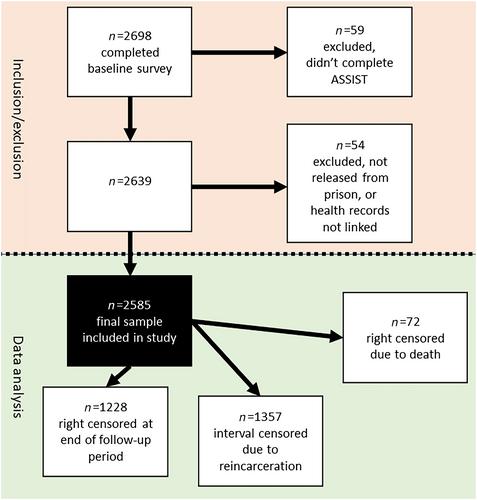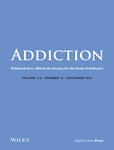Poor substance use-related health outcomes after release from prison are common. Identifying people at greatest risk of substance use and related harms post-release would help to target support at those most in need. The Alcohol Smoking and Substance Involvement Screening Test (ASSIST) is a validated substance use screener, but its utility in predicting substance-related hospitalisation post-release is unestablished. We measured whether screening for moderate/high-risk substance use on the ASSIST was associated with increased risk of substance-related hospitalisation.
A prospective cohort study.
Prisons in Queensland and Western Australia.
Participants were incarcerated and within 6 weeks of expected release when recruited. A total of 2585 participants were followed up for a median of 873 days.
Baseline survey data were combined with linked unit record administrative hospital data. We used the ASSIST to assess participants for moderate/high-risk cannabis, methamphetamine and heroin use in the 3 months prior to incarceration. We used International Classification of Diseases (ICD) codes to identify substance-related hospitalisations during follow-up. We compared rates of substance-related hospitalisation between those classified as low/no-risk and moderate/high-risk on the ASSIST for each substance. We estimated adjusted hazard ratios (aHR) by ASSIST risk group for each substance using Weibull regression survival analysis allowing for multiple failures.
During follow-up, 158 (6%) participants had cannabis-related, 178 (7%) had opioid-related and 266 (10%) had methamphetamine-related hospitalisation. The hazard rates of substance-related hospitalisation after prison were significantly higher among those who screened moderate/high-risk compared with those screening low risk on the ASSIST for cannabis (aHR 2.38, 95% confidence interval [CI] 1.74, 3.24), methamphetamine (aHR 2.23, 95%CI 1.75, 2.84) and heroin (aHR 5.79, 95%CI 4.41, 7.60).
Incarcerated people with an Alcohol Smoking and Substance Involvement Screening Test (ASSIST) screening of moderate/high-risk substance use appear to have a significantly higher risk of post-release substance-related hospitalisation than those with low risk. Administering the ASSIST during incarceration may inform who has the greatest need for substance use treatment and harm reduction services in prison and after release from prison.



